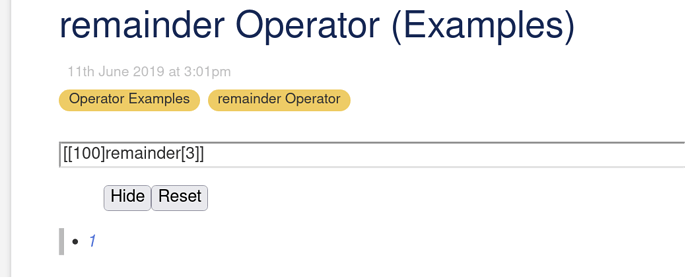Place the following code in a tiddler on tiddlywiki.com to see “The mathematics remainder operator is incorrect, it is a modulo operator”
- We also do not have the complement to the correct remainder operator the simple integer or int.
[Edited] The above .remainder operator needs work to cope with numbers that may not contain a period, ie whole numbers.
\function .int() [split[.]first[]]
\function .remainder() [split[.]last[]addprefix[.]]
\function .modulo(a) [divide<b>.remainder[]multiply<b>round[]]
\procedure analysis(a b)
;For a=<<a>>, b=<<b>>
# a divide b {{{ [<a>divide<b>] }}}
## Ceil {{{ [<a>divide<b>ceil[]] }}}
## .Int {{{ [<a>divide<b>.int[]] }}}
## .remainder {{{ [<a>divide<b>.remainder[]] }}}
# a remainder b {{{ [<a>remainder<b>] }}}
## a modulo b {{{ [<a>.modulo<b>] }}}
\end
<<analysis 100 3>>
<<analysis 100 6>>
- Further see my custom operators with a leading
.for comparison.
Questions
- Is my assertion correct?
- what if anything can we do to fix this?
- How do we maintain backward compatibility with an error?
- Shall we make/fix the int/remainder operators?


 You really need to stay and fight these things out. We both know there is a real answer, and we understand why it’s not what some people assume. So it’s incumbent upon us to correct them.
You really need to stay and fight these things out. We both know there is a real answer, and we understand why it’s not what some people assume. So it’s incumbent upon us to correct them.
